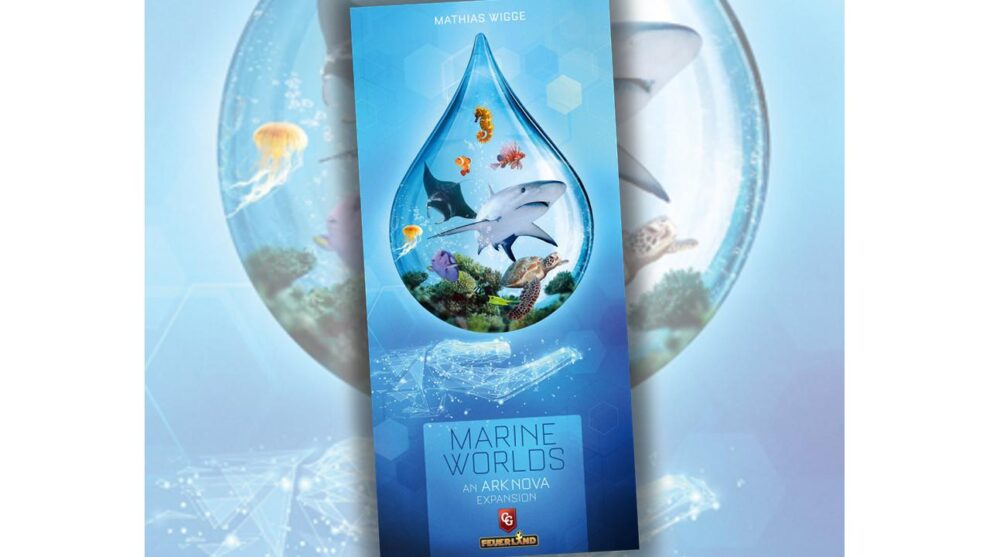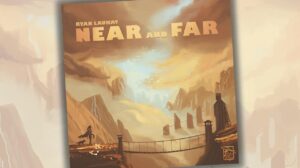Disclosure: Meeple Mountain received a free copy of this product in exchange for an honest, unbiased review. This review is not intended to be an endorsement.
Three years in, Ark Nova is still pretty hot.
The 2021 release—published by Feuerland Spiele in some parts of the world, Capstone Games in the US—stands at #4 on the BGG list of all-time fan favorites, and every time I go to conventions I see the big Ark Nova sign at the Capstone booth with fans diving headfirst into their personal zoo mats, sponsor cards, partner universities and hundreds of animal cards.
I am always pleasantly surprised how often I go to board game cafes or group game nights and see a copy of Ark Nova on a table. Some of the gaming couples I know say that Ark Nova is still their most frequent two-player game activity, particularly those that have kids and wrap up a long weekend with a quiet night of hunting through a massive discard pile for the first reptile card they can surface.
It was only a matter of time before we got our first “real” expansion. (While I won’t discount the release of Ark Nova: Zoo Map Pack 1, my britches weren’t exactly on fire when I learned that new player mats were released into the world without any extras. Look, I get it—the publishers and designer Mathias Wigge have gotta make money. Still, I would have preferred new maps AND new cards, if we are being picky.)
The release of Ark Nova: Marine Worlds (2023, Capstone Games) rights that earlier wrong. This expansion gets us new Zoo cards, new partner universities, new bonus tiles, and, most importantly, new action cards, which partially replace the five cards that sit below each player’s zoo mat to dictate what a player can do on their turn.
Note from my hot take on Ark Nova two years ago that I am not a hardcore, all-everything Ark Nova junkie. If I’m being honest, I still think the Ark Nova base game is pretty good, but not one of the five best games ever made. However, I am increasingly in the minority. Many friends across my five gaming groups believe Ark Nova is still the best “tag-driven” tableau builder ever, eclipsing similar titles such as Terraforming Mars, Earth, and recent additions to the canon like Ancient Knowledge.
In fact, one of the guys in my strategy gaming group logged his ONE HUNDREDTH play of Ark Nova earlier this year. About a quarter of his plays are cardboard/”in real life” plays, with the rest coming via the admittedly stellar implementation on Board Game Arena. (“I just love that BGA does all the clean-up for me,” this friend says, and I agree.)
When Capstone offered a review copy of Ark Nova: Marine Worlds, it was easy to say yes…almost everyone I know likes Ark Nova so I got the game to the table three times in three nights (a four-player game, a three-player game, and a solo play).
More is more, and in the case of Ark Nova: Marine Worlds, more is also better.

The Minor New Stuff
It’s easy to summarize the new modules with Ark Nova: Marine Worlds, so we’ll start with the minor stuff.
New Universities
Marine Worlds offers a fourth university option—a generic placeholder university tile that, when selected, offers a selection of six new universities. Each one is tagged with one of the six animal species (including the newest species, Sea Animals) as well as a single research tag.
An easy addition that aids playing cards into your zoo as well as helping to qualify for the Conservation Project cards? Yes, please. The base game’s association mat is swapped out for a new one in this expansion, there are almost no new rules to add here, and players are limited to grabbing just one of the new universities each game just like the base game’s partner universities.
A minor but important bonus: when a player selects one of these universities—and each player is limited to just one of these per game—they get to dig through the draw deck until they find an animal of that type to add to their hand. It’s like basically getting two tags to add to your tableau, in addition to what you already have in your hand. YES!!
The New Universities module is a home run.
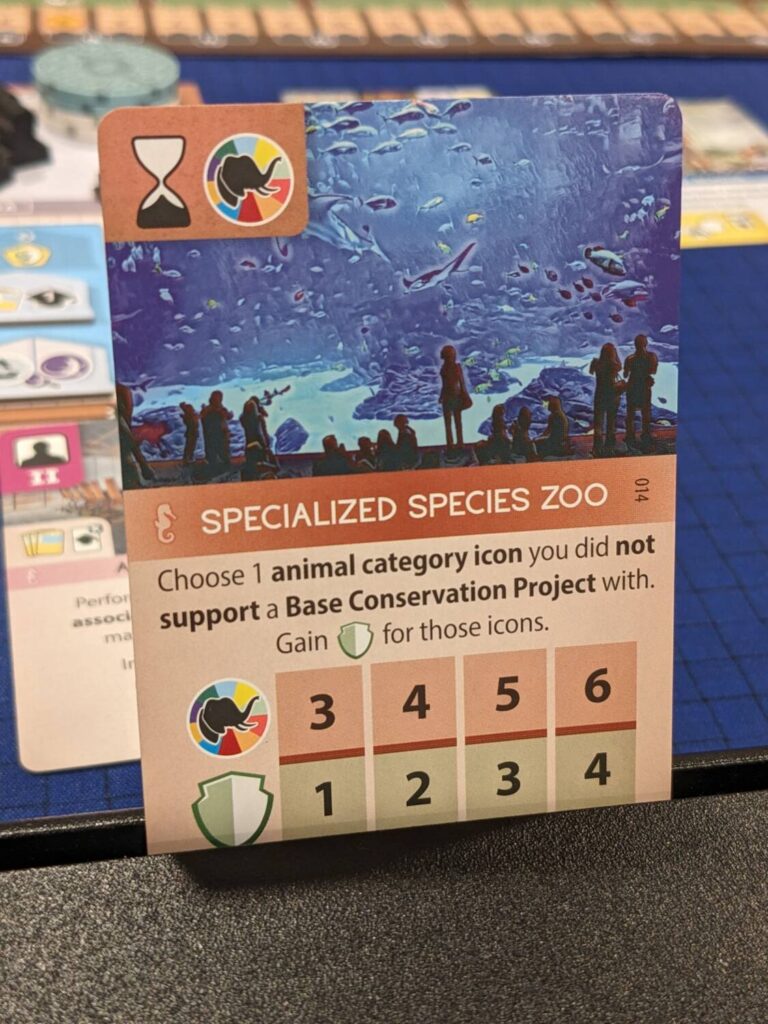
New Bonus Tiles
I love the six new tiles here (plus a seventh, which replaces the “buy a sponsor card with cash” tile from the base game with a new icon). All of them are great, but a big thumbs-up to the fact that some of the bonuses can be saved for later, as opposed to forcing a player to use the bonus immediately. I loved the tile that let me place three one-space buildings (kiosks, for example) in my zoo for free, in part because that power helped me fill the final three spaces in my zoo to earn seven appeal points in my four-player game.
These new bonus tiles are shuffled into the options from the base game, so this is simply another addition that improves the amount of choices during setup. Another home run.
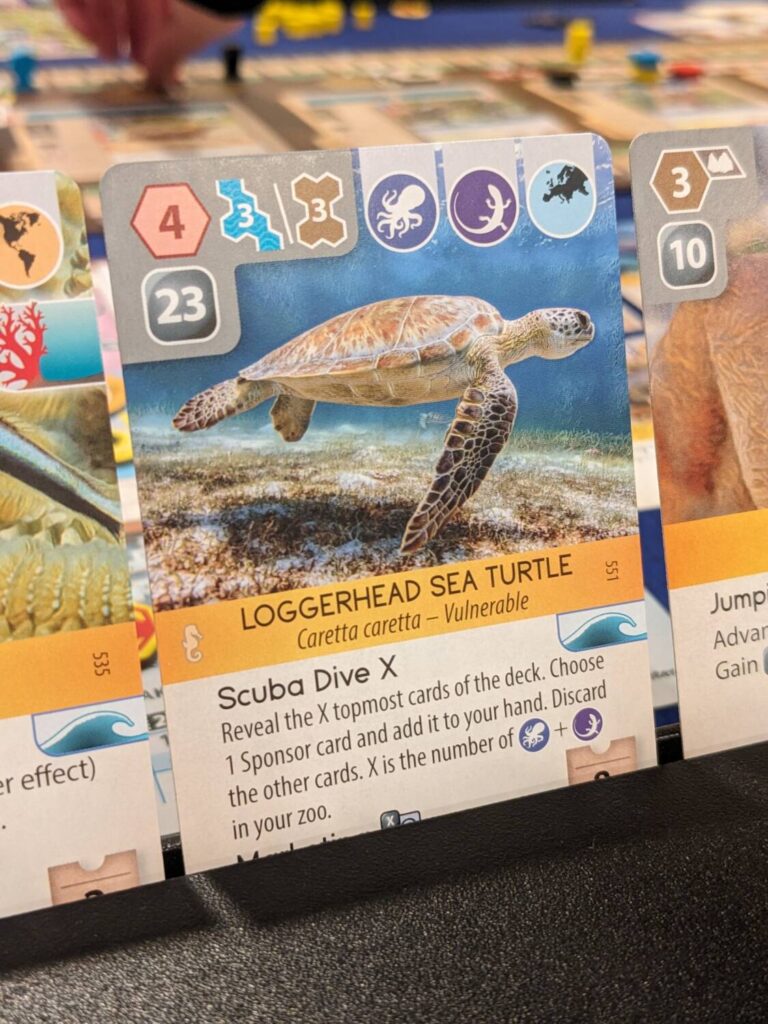
The Wave Icon
Card cycling is an issue all tableau builders with a card market suffer through, and Ark Nova is no exception. Many of the new Zoo cards in Marine Worlds have a small wave icon below the card title. When a wave card appears in the market (known as the “display” in Ark Nova), the card at the end of the display is pushed out, creating a slightly increased cascade of cards.
This is maybe the most insignificant addition to the Ark Nova system, but I like it. We saw maybe a dozen new cards as a result during each multiplayer game, and it creates a minor churn vital for players hunting for better/different cards in the display.
Alternate Player Tokens
Another set of bits that I would not buy on their own, Marine Worlds includes seven alternate player tokens per color for use on the Conservation Project cards, to distinguish themselves from simple wooden cubes.
But the new tokens are cute! And some people will now want to be, say, fish (blue) or penguins (black) instead of just blue or black. So, that’s a win, and it does add some nice visual flair when everyone drops their tokens on the base Conservation Project cards for scoring purposes.
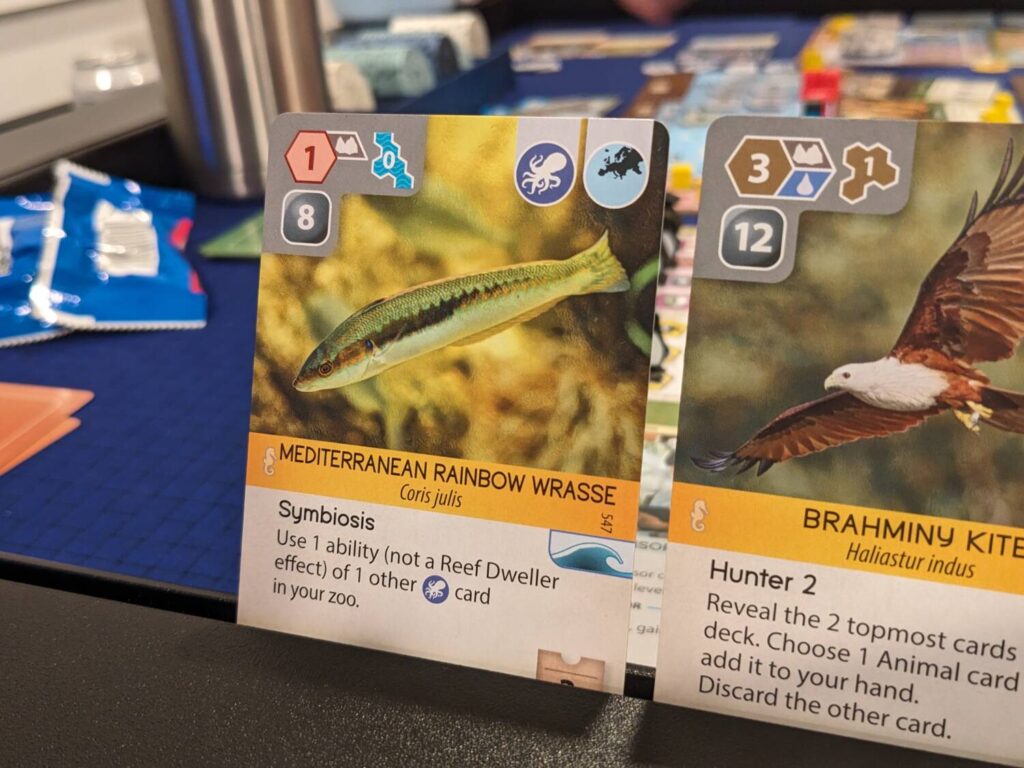
The Major New Stuff: Cards
At the end of the day, Marine Worlds is about the cards. Luckily for all of us, there are a lot of good things to talk about with the new stuff.
More Zoo, Final Scoring, and Base Conservation Project Cards
54 new Zoo cards are included in Marine Worlds, with a majority of these being Sea Animals that must be housed in a new building type, aquariums (although, as we found during my first playthrough with the expansion, there is a building from the base game called Aquarium that does not house Sea Animals). The Zoo cards, added to a half-dozen or so final scoring cards as well as a half-dozen base Conservation Project cards that align closely to the newly added Zoo cards, are “more for the sake of more.”
For an Ark Nova player used to shuffling a couple hundred cards during setup, adding 50 more cards is an easy lift.
For a regular joe like me, this mountain of cards feels like the game Earth. How many cards are too many cards? I thought there were too many cards in the Ark Nova base game. But, at least in the four-player game, we saw about 75% of the cards across the four players and, if anything, I really appreciated not having to reshuffle a discard pile every 30 minutes. There ain’t no way you are going through all these cards in a single game of Ark Nova, so if that’s a benefit to you, you are going to want this expansion.
The new cards themselves? I liked the addition of sea animals as another pursuit, and about half of the newest Zoo cards have a Reef Dweller icon printed on them. (Yes, more icons!!) Reef Dweller powers stack by triggering other Reef Dweller cards in your zoo. I used a two-card Reef Dweller combo to get association meeples back into my supply for free, which felt like my own personal cheat code.
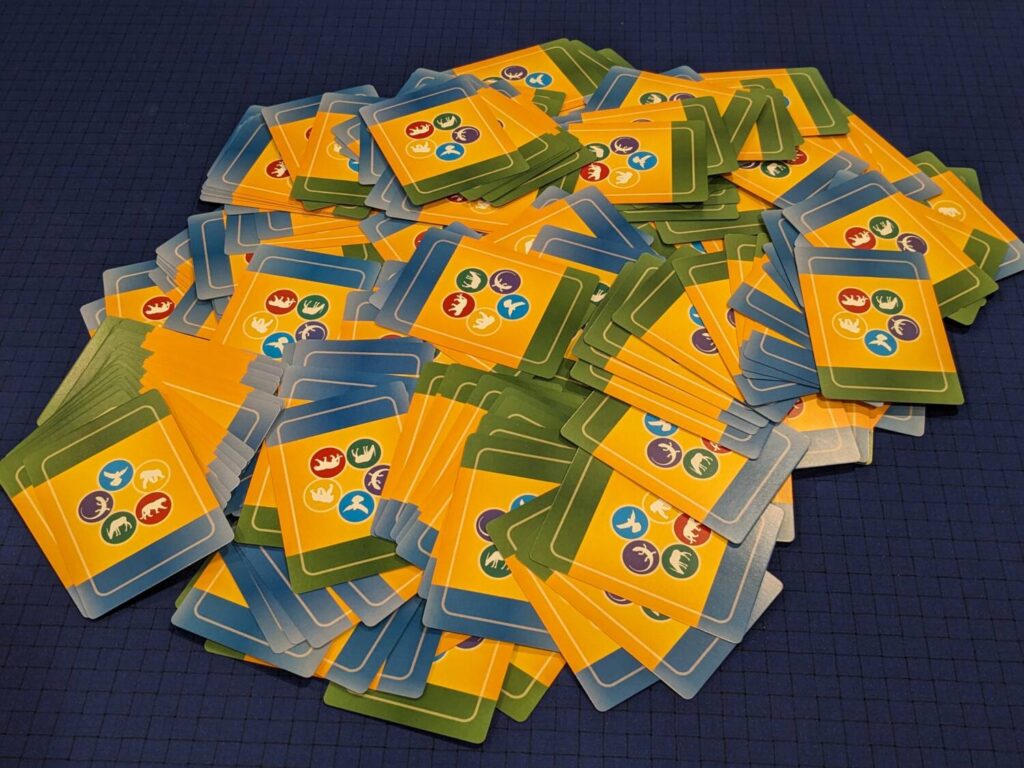
The Action Cards
One might argue that 50 new Zoo cards would be enough to warrant the purchase of this expansion. I would disagree, so let’s go with the following for my endorsement:
Come for the Zoo cards, but stay for the new action cards.
The game’s five base actions have not changed with this expansion. Animals, Cards, Sponsors, Association, and Build are still the game’s core actions. In Marine Worlds, all players start with the five double-sided action cards from the base game. After maps are selected, an action card draft takes place.
Each player is dealt three new action cards. These new action cards are a mix of four slightly different new versions of the same action. For example, there are four versions of the Animals card, each with a slight tweak to what it does. That means there are 20 available action cards, four of each type of the five base actions.
So each player considers their pool of three new cards, then keeps one and passes the other two to the player on their left. From these three cards (the one they were passed, plus the two that remained from their passing to a different player), each player keeps two of the three and tosses the third out of play. The two new cards then replace their matching action from the base game’s action cards, leaving each player with the five main actions, but two of those are slightly better and unique versions of those actions.
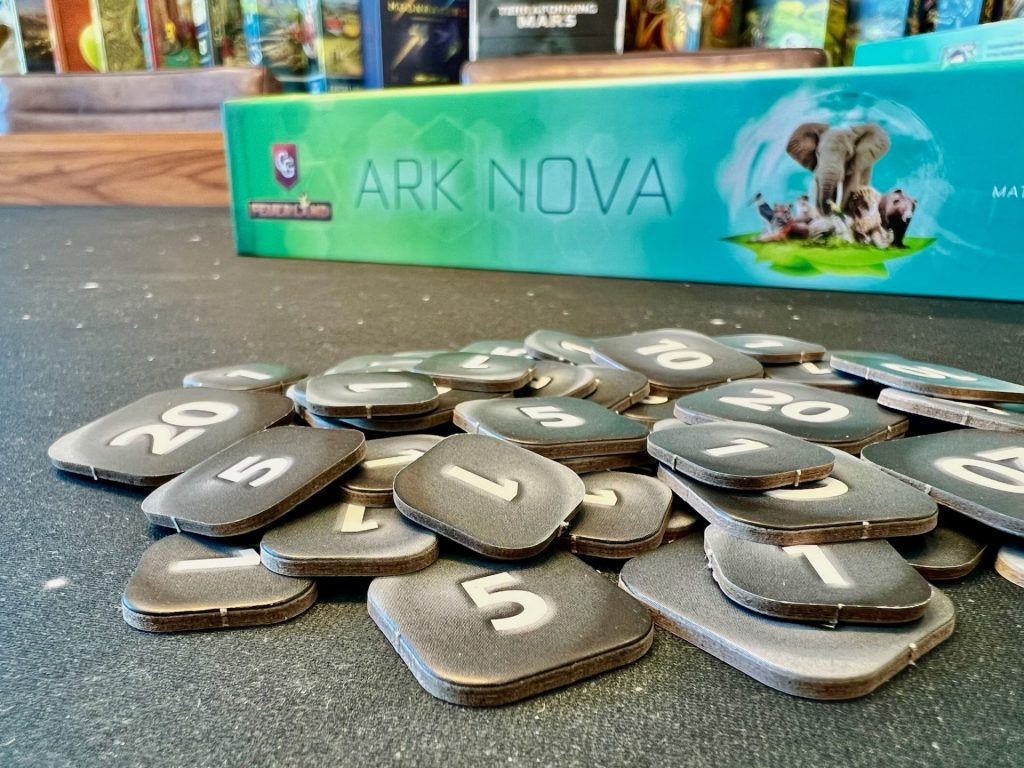
First, I absolutely love the idea that players are only dealt three cards, as opposed to being dealt one of each action’s new cards, for the draft. Ark Nova already has a front-loaded downtime problem with players taking a few minutes picking their first four Zoo cards from the eight they are dealt. Adding a long action card draft to that could mean 5-10 minutes (or more) of sitting time before playing a game that I’ve seen run for 3-4 hours with four players.
Second, the action cards themselves are great, but more importantly, I already think some are better than others, hence the draft. During my first setup of the new stuff, I read all 20 new action cards. I already have a few I would pick over others, and I can almost certainly say that the Association cards are my favorite of the new stuff.
Each player will have a different approach to their games, and because this choice has to be made before seeing your Zoo cards, I like that there’s some gambling to how well your choices affect your start-up.
Third, I like that you only get two juicier cards for the five actions. 60% of your Ark Nova gameplay, every game, remains unchanged. That new 40%? It can be spicy. And it can really change from game to game, with all those new cards mixed with these new abilities.
I had a new Animals card in one play that allowed me to select a new Animal card from a four-card draw if I finished that action with no Animal cards in hand. In another game, I had a Build card that always allowed me to build with a strength of +1, as if I had a standing X token for my Build action. Another player in my four-player game had an Association card that, if used with a strength at level five, could unlock an Association worker as long as they didn’t back a project on that turn.
The new action cards are a must for experienced players, but I don’t think the cards should be used in anyone’s first play of Ark Nova, whereas the other additions feel like they should be included from the jump. There’s just enough of a rules overhead boost that I think the new action cards really shine for those who have their Ark Nova sea legs, but not as much for people already overwhelmed with 200 cards and almost as many individual icons.
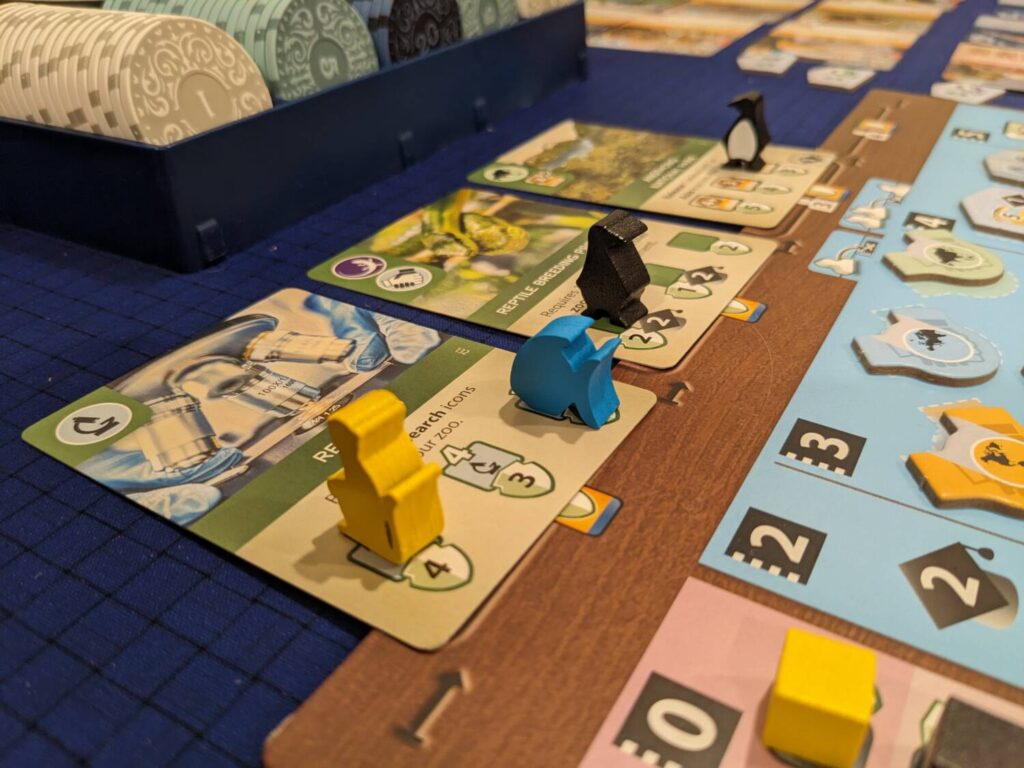
An Easy Recommendation
If you love Ark Nova, you have already bought the Marine Worlds expansion. For those who play Ark Nova a couple times a year, I still think Marine Worlds is a worthy addition to the base game. My colleague Dave Wood also enjoyed this expansion for many of the reasons I expanded on in this review.
My issues with Marine Worlds are minor. The game has done nothing to speed up play, so Ark Nova is still best as a solo or two-player game. My two multiplayer games took 3.5 hours (the four-player game) and 2.5 hours (the three-player game). I still pause during Ark Nova plays when someone has 40 appeal and a dozen conservation points and realize that we are another 45 minutes from finishing the game.
Ark Nova’s BGA implementation makes this even tougher—it’s the same game, but faster, so if I’m playing Ark Nova solo, I’m playing it online 100% of the time.
My other issue is a one-time problem: about 40 cards in the expansion replace matching cards from the base game. That meant going through a couple hundred cards to swap in the new cards. Not a gamebreaker, but it means you will need to spend 20-25 minutes before your first play with the expansion, cleaning things up to produce an expansion-ready play.
Beyond that, Ark Nova: Marine Worlds is a winner thanks to the new action cards. That and the new Zoo cards make for a handsome package, with some nice extras like the bonus tiles, to shake up the base game setup. The new stuff all fits in the base game box (after you dump the Marine Worlds expansion box, which is not needed), so another nice plus is that all my Ark Nova stuff sits in one box.
Ark Nova: Marine Worlds. Get in there, animal lovers!


